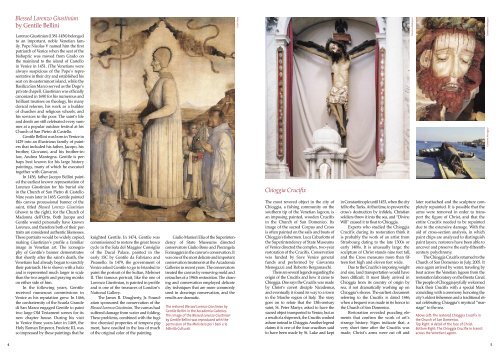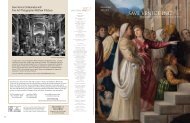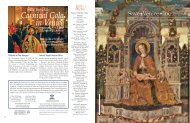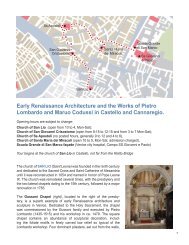5780-2005 Newsletter-v6.indd - Save Venice Inc
5780-2005 Newsletter-v6.indd - Save Venice Inc
5780-2005 Newsletter-v6.indd - Save Venice Inc
You also want an ePaper? Increase the reach of your titles
YUMPU automatically turns print PDFs into web optimized ePapers that Google loves.
Blessed Lorenzo Giustinianby Gentile BelliniLorenzo Giustinian (1381-1456) belongedto an important, noble Venetian family.Pope Nicolas V named him the firstpatriarch of <strong>Venice</strong> when the seat of thebishopric was moved from Grado onthe mainland to the island of Castelloin <strong>Venice</strong> in 1451. (The Venetians werealways suspicious of the Pope’s representativein their city and established hisseat on its easternmost island, while theBasilica San Marco served as the Doge’sprivate chapel). Giustinian was officiallycanonized in 1690 for his numerous andbrilliant treatises on theology, his manyclerical reforms, his work as a builderof churches and religious schools, andhis services to the poor. The saint’s lifeand deeds are still celebrated every summerat a popular outdoor festival at hisChurch of San Pietro di Castello.Gentile Bellini was born in <strong>Venice</strong> in1429 into an illustrious family of paintersthat included his father, Jacopo, hisbrother, Giovanni, and his brother-inlaw,Andrea Mantegna. Gentile is perhapsbest known for his large historypaintings, many of which he executedtogether with Giovanni.In 1456, father Jacopo Bellini paintedthe earliest known representation ofLorenzo Giustinian for his burial sitein the Church of San Pietro di Castello.Nine years later in 1465, Gentile paintedthis canvas processional banner of thesaint, titled Blessed Lorenzo Giustinian(shown to the right), for the Church ofMadonna dell’Orto. Both Jacopo andGentile would personally have knownLorenzo, and therefore both of their portraitsare considered authentic likenesses.These portraits would be widely copied,making Giustinian’s profile a familiarimage in Venetian art. The iconographyof Gentile’s banner demonstratesthat shortly after the saint’s death, theVenetians had already begun to sanctifytheir patriarch. He is shown with a haloand is represented much larger in scalethan the two angels and praying monkson either side of him.In the following years, Gentilereceived numerous commissions in<strong>Venice</strong> as his reputation grew. In 1466,the confraternity of the Scuola Grandedi San Marco engaged Gentile to painttwo large Old Testament scenes for itsnew chapter house. During his visitto <strong>Venice</strong> three years later in 1469, theHoly Roman Emperor, Frederic III, wasso impressed by these paintings that heknighted Gentile. In 1474, Gentile wascommissioned to restore the great frescocycle in the Sala del Maggior Consiglioof the Ducal Palace, painted in theearly 15C by Gentile da Fabriano andPisanello. In 1479, the government of<strong>Venice</strong> asked Gentile to go to Istanbul topaint the portrait of the Sultan, MehmetII. This famous portrait, like the one ofLorenzo Giustinian, is painted in profileand is one of the treasures of London’sNational Gallery.The James R. Dougherty, Jr. Foundationsponsored the conservation of theBlessed Lorenzo Giustinian. The canvas hadsuffered damage from water and folding.These problems, combined with the fugitivechemical properties of tempera pigment,have resulted in the loss of muchof the original color of the painting.Giulio Manieri Elia of the Superintendencyof State Museums directedconservators Giulio Bono and PierangelaFormaggini in the canvas’s conservation. Itwas one of the most delicate and importantconservation treatments at the AccademiaGalleries in recent years. The conservatorstreated the canvas by removing mold andretouches of a 1960s restoration. The cleaningand conservation employed delicatedry techniques that are more commonlyused in drawings conservation, and theresults are dramatic.The restored Blessed Lorenzo Giustinian byGentile Bellini in the Accademia Galleries.This image of the Blessed Lorenzo Giustinianby Gentile Bellini was reproduced with thepermission of the Ministero per i beni e leAttività Culturali.Giulio BonoChioggia CrucifixThe most revered object in the city ofChioggia, a fishing community on thesouthern tip of the Venetian lagoon, isan imposing painted, wooden Crucifixin the Church of San Domenico. Itsimage of the sacred Corpus and Crossis often painted on the sails and boats ofChioggia’s fishermen. Luca Caburlotto ofthe Superintendency of State Museumsof <strong>Venice</strong> directed the complex, two-yearrestoration of the Crucifix. Conservationwas funded by <strong>Save</strong> <strong>Venice</strong> generalfunds and performed by GiovannaMenegazzi and Roberto Bergamaschi.There are several legends regarding theorigin of the Crucifix and how it came toChioggia. One says the Crucifix was madeby Christ’s covert disciple Nicodemus,and eventually it found its way to a townin the Marche region of Italy. The storygoes on to relate that the 13th-centurysaint, St. Peter Martyr, asked to have thesacred object transported to <strong>Venice</strong>, but asa result of a shipwreck, the Crucifix washedashore instead in Chioggia. Another legendclaims it is one of the four crucifixes saidto have been made by St. Luke and keptin Constantinople until 1453, when the cityfell to the Turks. At that time, to prevent thecross’s destruction by infidels, Christiansoldiers threw it into the sea, and “DivineWill” caused it to float to Chioggia.Experts who studied the ChioggiaCrucifix during its restoration think itis probably the work of an artist fromStrasbourg dating to the late 1300s orearly 1400s. It is unusually large: thesculpture of Christ stands nine feet tall,and the Cross measures more than fifteenfeet high and eleven feet wide.Due to the Crucifix’s imposing weightand size, land transportation would havebeen difficult. It most likely arrived inChioggia from its country of origin bysea, if not dramatically washing up onChioggia’s shores. The earliest documentreferring to the Crucifix is dated 1446,when a bequest was made in its honor tothe Church of San Domenico.Restoration revealed puzzling elementsthat confirm the work of art’sstrange history. Signs indicate that, avery short time after the Crucifix wasmade, Christ’s arms were cut off andGiovanna Menegazzilater reattached and the sculpture completelyrepainted. It is possible that thearms were removed in order to transportthe figure of Christ, and that theentire Crucifix needed to be repainteddue to the extensive damage. With theaid of cross-section analysis, in whichpaint chips are analyzed to distinguishpaint layers, restorers have been able touncover and preserve the early-fifteenthcenturypolychromy.The Chioggia Crucifix returned to theChurch of San Domenico in July, <strong>2005</strong>. Itonce again arrived by water, traveling byboat across the Venetian lagoon from therestoration laboratory on the Brenta Canal.The people of Chioggia joyfully welcomedback their Crucifix with a special Masscoinciding with a ceremony honoring thecity’s oldest fishermen and a traditional ritualcelebrating Chioggia’s mystical “marriage”to the sea.Above Left: The restored Chioggia Crucifix inthe Church of San Domenico.Top Right: A detail of the face of Christ.Bottom Right: The Chioggia Crucifix in transitacross the Venetian Lagoon.Giovanna MenegazziGiovanna Menegazzi4 5





